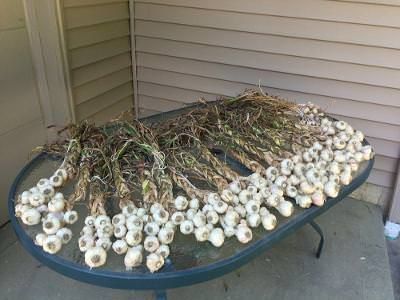L’aglio, il re del cibo americano-italiano, è il primo sapore che molte persone riconoscono quando mangiano. Nella famiglia Piertraroia, l’aglio è il produtto più importante nella loro cucina ed anche il loro orto. Nel secolo passato, l’aglio fu mangiato perché ritenuto economico e fu considerato come cibo dei contadini. I nonni dello scrittore crebbero lo stesso aglio per più di cinquanta anni, chiamato Rocambole. Questo aglio è piantato in ottobre o novembre ed è pronto da raccogliere a luglio. Per molte famiglie, c’è la tradizione di fare una treccia con gli agli e dare come un regalo alle famiglie e gli amici. Per questo, l’aglio è un alimento molto speciale nella cucina italiana e per molte famiglie.
When you think of Italian food, what is the first flavor or smell that comes to mind? In our family, that would be garlic. There is a long list of the many vegetables, herbs and spices that Italian American families grow and cook with. Garlic is the undisputed King of Italian American cuisine flavors. From garlic bread to garlic infused olive oil, garlic can be roasted, minced, powered, or caramelized whole in countless dishes.
In our family, our garden would not be complete without garlic. In fact, the planting, harvesting, braiding, and dehydrating of garlic has become somewhat of a tradition all its own. Our garlic harvest is much anticipated by family and friends. But first, some garlic history.
Before the turn of the last century, garlic was considered a plant that only the poor ate because it was cheap. As a matter of fact, the eating of vegetables was looked down upon because no one knew the nutritional value of vegetables. The poor in Italy and other countries ate a lot of vegetables such as radicchio, arugula, artichokes, and eggplant, seasoned with spices like garlic, oregano, basil, fennel, and more.
Our family’s tradition of planting garlic is rooted with my grandfather Michelangelo, who was born in the town of Cercepiccola near Campobasso. On his and Nonna’s wedding license, their occupations were listed as Contadino and Contadina, respectively. He always had a garden. Most Italian Americans have and love their gardens. We have always had large gardens. We have been growing the same type of garlic for over 50 years, it is called Rocambole. It is what is called hardneck garlic; a slightly spicy garlic that, when it is fully ripened, is colored with beautiful streaks of purple on the cloves. Most Italian Americans in this area of the country observe the tradition of planting the garlic by Columbus Day, but if you get the cloves in the ground before November you will be ok. Plant about 2 inches deep and about 6 inches apart in rows 2 feet apart in full sun. Mulch over the planted cloves with 2-3 inches of leaf mulch.
During a winter thaw, we will see tiny green shoots poke their sprouts through the leaves and snow, reaching toward the sun. That is the first sign that the garlic crop for the coming year is on its way. Around the first of June, a special time arrives that all garlic aficionados wait in anticipation for, garlic scapes. These are the wonderfully tender and mild shoots that spring from the center of the plant. If left alone and not harvested, they will become the plants’ seed pod. We harvest them and give bundles of them to family and friends to use in salads, soups, omelets, stir fries, etc.
About 4 to 5 weeks later, around July 10, when the first 2 or 3 bottom garlic leaves begin to turn brown and die, it is time to harvest the garlic. Always use a 4-prong pitchfork to harvest garlic, to avoid damage to the bulbs. Wash the dirt from the bulbs and let them dry. Next, tie them with twine into bundles of 12 and hang in the shed or barn for 1 week to cure them. You are now ready to sort the bulbs by size. The best should be used for braiding and for next year’s crop. The smaller bulbs are usually dehydrated for garlic power, which is the method that will keep the longest. It will be the best garlic powder you ever tasted!
French braid the leaves of the bulbs to give as gifts to family and friends (you can learn how to online). It is a thing of beauty to see a braid of 9 or 10 large bulbs hanging in cucini across northeast Ohio. Braiding is a great source of pride and accomplishment and it is a tradition worth passing down to the next generation.
In northeast Ohio’s wonderful but relatively short growing season, another Italian tradition is passed on from one generation to another, insuring that in the coming year another crop of garlic will be harvested and grace our kitchens and flavor our food, just as it has happened for centuries. Keep another tradition alive; grow, harvest and enjoy the best garlic you will ever taste. Amore.



